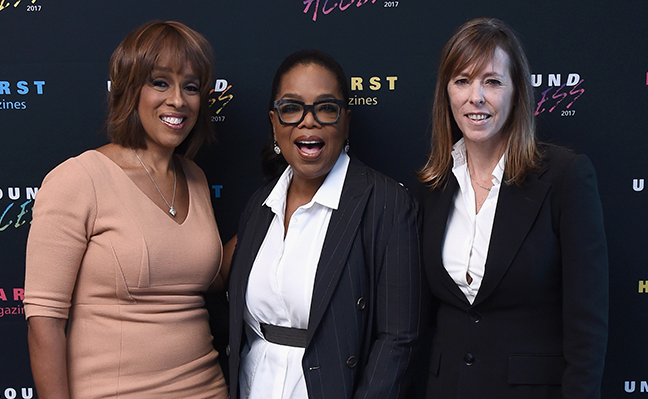Hearst MagFront, Key to Content Marketing, Digital vs. Traditional Ad Projections, Views on Facebook and Google, TFP CEO Margot Knorr Mancini: Digital News Media, InDesign CC Tip: Mobile Intent Page Sizes
Welcome to Technology for Publishing’s roundup of news and tips for media industry pros! This week, we’re sharing stories about Hearst’s MagFront pitch to advertisers, how to succeed in content marketing, projections showing digital ads overtaking traditional ad media, the challenges publishing executives face as Facebook and Google become more dominant, and more.
- Hearst Magazines held its fourth annual MagFront, an event to showcase upcoming content across titles along with sponsorship opportunities. As an Adweek post noted, the event gathered editors of each of Hearst’s 21 brands to pitch their 2017 editorial plans to the 200 advertising and marketing executives in attendance. O, The Oprah Magazine editor at large Gayle King, Oprah Winfrey, and EIC Lucy Kaylin (pictured) were on hand to preview their “year in adventure” theme, which includes an Oprah-branded cruise. At Cosmopolitan, editor Michele Promaulayko and her team are planning a “year of beauty” native push, integrating custom advertising across platforms, including print, digital, and social channels. Marketing and publishing director Michael Clinton said partnerships like Lena Dunham’s “The Lenny Letter” will also be a big focus in the new year, with new chief content officer Joanna Coles leading efforts to create even more celebrity, influencer, and brand partnerships, according to the post.
- Like it or not, content marketing has become a key focus in the publishing industry as companies grapple to offset dwindling revenue in other areas. On Folio’s site, top content marketer Joe McCambley shared his expertise on the subject in a Q&A, noting that there’s “a huge demand for the content that publishers have typically created.” He added, however, the No. 1 thing publishers often miss is overall strategy. Having advised brands like Microsoft, Starbuck’s, and Nike and publishers including The Huffington Post, National Geographic, and AARP, POP’s McCambley emphasized that an effective content strategy needs to encompass all campaigns and promotions, not just individual initiatives. The interview also touched on how publishers can make themselves more attractive to brands, the division between church and state, and the outlook for smaller publishers.
- Still more in the advertising world: A newly released BIA/Kelsey projection showed U.S. local-market digital ads will outsell traditional ad media by 2018. The firm said the overall increase in local ad revenue can be attributed to an uptick in the U.S. economy, an increase in spending by national brands and local channels, and significant growth in mobile and social advertising and other digital and online platforms, according to an Advertising Age post. It added that the drop in traditional ad revenue reflects in part the ongoing downturn in the newspaper industry as a whole. See last week’s This Week in Publishing post for recent newspaper industry projections and analysis.
- We also saw yet more posts on the challenges publishers are continuing to have with tech giants Facebook and Google. Digiday, for one, offered insights from media executives attending its recent publishing summit, with top complaints being constant algorithm changes and lack of monetization options. “Facebook is all powerful, and it knows it,” said Robert Hodges, head of audience development at Sky. Meanwhile, Guardian Media Group CEO David Pemsel told Business Insider his views on Google and Facebook depend on “what day of the week it is.” Right now, the media company’s relationship with the former is strained, he said, as the search giant recently “poached” two of the Guardian’s product development team members. Aside from that, the biggest problem Pemsel has with the “Big 2” is their affect on the publisher’s digital advertising revenue: “The ad model is as broken as it’s ever been. All programmatic trading has reduced yield, it does not value context, and it has allowed a very efficient approach to targeting. This has meant that Google and Facebook have been able to hoover up a huge amount of digital ad spend.” In the face of big losses, the newspaper will have to cut costs by more than 60% to stay afloat, Politico reported.
On the Technology for Publishing Blog
- In her latest article, TFP CEO Margot Knorr Mancini examines the top factors impacting the digital news business today and how leading media organizations are responding to them.
- October Book Picks: This month’s related recommended reading focuses on transformation and innovation in digital news media. Learn what industry experts have to say as you prepare for what’s ahead.
- Save time! In this week’s InDesign CC Tip, Monica Murphy shows you how to use updated Mobile Intent page size options that make it easier to create layout renditions for multiple devices.
- Also check out TFP’s most recent infographic pick, highlighting the “entertechment” market, where the marriage of tech and entertainment are creating big opportunities for media and other companies.
Photo: Adweek
Visit our blog for highlights of interesting and noteworthy stories from the publishing world every Friday, and sign up for TFP’s This Week in Publishing newsletter. Think we missed something great? Let us know! Leave a comment below or drop us a note.
Posted by: Monica Sambataro



